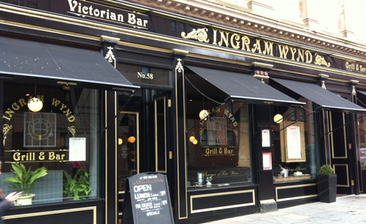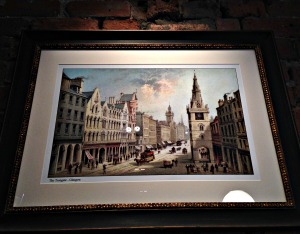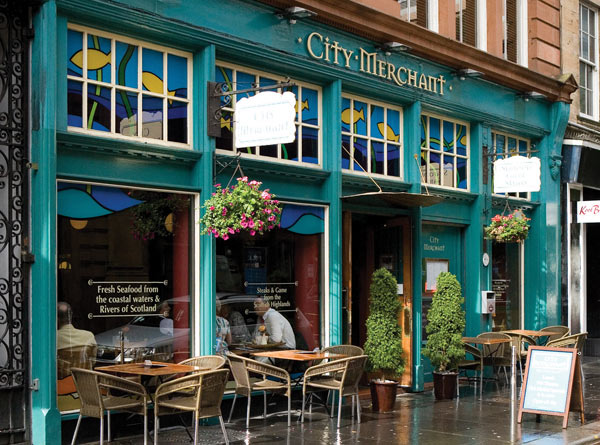Now a bustling hub of restaurants, clubs and cafes, the Merchant City has a rich history and a background of commerce, trade and rich residences and coinciding with this, a fascinating food and drink history.
Early Merchant City
The area around the Merchant City was where Glasgow, as a city, first began as a fishing settlement around the 6th century. Trading has always been key to the area’s wealth and daily activity; in the early middle ages the area had a salt market (the area has retained the market’s name, the Saltmaket, just south of the Merchant City), a fruit and vegetable market in Gallowgate, a meat market between Candleriggs and Glassford Street, and a fish market as well as a grain market near High Street.

From the 1700s foreign trade began to flourish in Glasgow and some of the first foreign trade out of the city was the exporting of salmon and herrings to France. Glasgow merchants became incredibly wealthy and set up their homes in what became known as the Merchant City.
The Corinthian on Ingram Street, now a luxury venue with numerous restaurants, bars, a nightclub and casino, is on the site of one of the finest merchant’s residences, then called Virginia Mansion.
Trongate & Gallowgate
Any piece on the history of the Merchant City can’t fail to mention Trongate, one of the oldest parts of Glasgow and the original medieval centre of the city. The area was given the right to have public scales for weighing produce by the Bishop of Glasgow in the 1400s, called the Tron, which is where the area’s name came from.
The Tron Church and the Toolbooth clock tower in Gallowgate, which was part of a larger building housing the original city chambers, courts and the prison (the metal rings that chained prisoners to the wall still survive outside), are two of the oldest and most notable landmarks in the area slap bang in the middle of where important food trading was conducted.
Nowadays King Street plays host to the popular Italian restaurant ESCA but back in the 1700s King Street was where meat, fish and dairy products were traded.
Elsewhere in Trongate, restaurants Charcoals Cafe and Boteco do Brasil let you enjoy the roots of the area.
Glassford Street, whisky & riots
On the edge of Trongate, starts Glassford Street which has some interesting whisky history. A prominent merchant’s house, Shawfield Mansion, was virtually demolished after its owner Daniel Campbell voted to extend the Malt Tax to Scotland. A mob descended on the house in disagreement, then foot soldiers arrived resulting in riots.
Campbell received £9,000 following the destruction of his house and bought the now well-known whisky producing islands of Islay and Jura.
The mansion may be gone but Grosvenor Casino and Grill and Bacchus are good stop points for a bite to eat if you want to imagine the riots that once took place.
Ingram Wynd

Ingram Wynd is a Victorian themed restaurant on Ingram Street and features some fantastic historical memorabilia of old Merchant City on its walls. From replica ancient maps of the Merchant City to photos of landmark buildings of the area, it’s full of interesting artefacts.
Restaurant Manager Arnaldo Tugawin says:
“The owner loves the Merchant City’s history and wanted to display the area’s deep roots in the restaurant. This carries through to our menu which features tasty traditional Scottish dishes – the most popular item on our menu is Stovies!
“I love the Merchant City; it’s a hub for entertainment and dining out. I’m from the Philippines originally and whilst it took me a while to get used to the Scottish weather, the people made me feel very welcome.”
 ][5]
][5]Candleriggs
Continuing from Trongate, Candleriggs takes you into the heart of the Merchant City. It was built in the 1720s and was so called as it this is where the candlemakers originally resided.
In the centre of the Merchant City entered via Candleriggs lies the Old Fruitmarket, now a concert hall but as its name suggests was once a market place for fruit and vegetable sellers right up until the 1970s. It dominated the area during its time and was the hub of activity; the original seller’s name boards can still be seen in the venue.
The Merchant City during the Victorian times became more of a wholesale area, dominated by the Fruitmarket, as merchants moved to the developing West End.
It’s purported that the first Sugar Works in Scotland was established in 1667 on Bell Street, just off Candleriggs. On this corner you’ll now find the north Indian restaurant Dhabba.
Now on Candleriggs opposite the Old Fruitmarket you have restaurants like Dakhin and City Merchant and on Albion Street where its alternative entrance lies, you have delicious options like the Italian Caffe and Gandolfi Fish.
City Merchant

The City Merchant is in the heart of the historic area of Candleriggs. Not only does its name reference the Merchant City’s trading past but the Scottish restaurant keeps true to the area’s historic trading roots through its menu.
It uses the best local suppliers it can; from Hebridean salmon, Cumbrae oysters and Scottish langoustines (it’s the only Glasgow restaurant to get three fresh seafood deliveries every day) to Scottish reared meat from Campbell’s Prime Meats – even its ice cream is from Cream O’Galloway.
It also takes advantage of Scotland’s key trading status and imports specialities from other parts of the world, such as its coffee from Rome.
In the video below, Jennifer Armento, General Manger and part of the family who own City Merchant, talks about the history of Candleriggs and gives an insight into the popular restaurant.
Granny Black’s
Glaswegians have a reputation for their love of fried food and you could place some of the blame on Candleriggs for this. Candleriggs had Glasgow’s first takeaway, ‘Granny Black’s,’ on 35 Candleriggs, selling pies to customers eager for a greasy supper after a few drinks.
This pub takeaway is long gone and now on this southern end of Candleriggs you’ll find Guy’s Restaurant, Khublai Khan’s Mongolian BBQ and Wild Cabaret.
Notable building – Merchant Square
 ][14]
][14]In the early 1800s, Candleriggs played host to a bazaar housing fruit and vegetable sellers, a cheesemonger, egg, butter, ham and onion merchants (yes, there were merchants solely selling onions!).
Now Merchant Square duly keeps to it roots, maintaining the cobbled floor of the square with the restaurants surrounding it – great for people watching. The restaurants and bars all have outside areas looking into the square which has a glass ceiling, letting you enjoy the indoors outdoors.
If you want to absorb yourself in the Merchant Square’s past, Fanelli’s restaurant, Metropolitan Cocktail Bar & Restaurant and Arisaig are all based in Merchant Square.
References
http://www.scotcities.com/merchant.htm
http://glasgowmerchantcity.net/downloads/merchant-city-history.pdf
